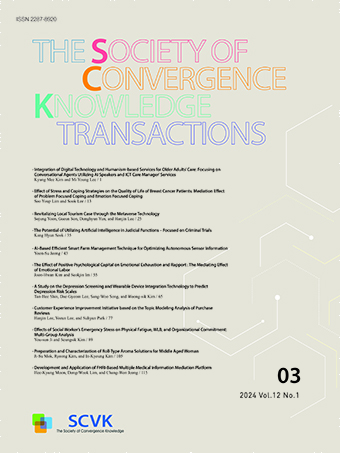Research Article
Abstract
References
Information
이 연구는 소비자 적개심이 국가이미지와 구매의도에 어떠한 영향을 미치는지를 검토하기 위한 목적으로 수행되었다. 구체적으로 이 연구의 대상국가로는 일본을 선정하였다. 일반적으로 한국인들은 일본에 대한 역사적인 적대감을 가지고 있어 왔다. 이런 가운데 최근 한일관계는 급속하게 악화되고 있다. 이런 상황 속에서 이 조사는 한국시장의 특성에 관한 기초적인 정보를 제공함과 더불어 우리나라 기업이 해외시장에 진출할 경우 소비자 적개심과 국가이미지 관련 고려해야 할 시사점을 제공하고자 하는 목적으로 수행되었다. 이를 위해 실증분석에서는 285명을 대상으로 한 소비자 적개심과 일본의 국가이미지에 관한 설문조사 결과를 SPSS 25.0과 AMOS 23을 사용하여 분석하였는데, 그 결과는 다음과 같다. 첫째, 일본의 국가이미지 차원은 경제이미지, 정치이미지, 관계이미지, 문화이미지, 국민이미지의 차원으로 나타났다. 둘째, 소비자 적개심이 국가이미지에 영향을 미친다는 가설을 검정한 결과 통계적으로 유의한 것으로 나타났다. 셋째, 소비자 적개심이 맥주의 구매의도에 영향을 미친다는 가설을 검정한 결과, 유의한 영향을 미치는 것으로 나타났다. 또한 소비자 적개심이 의류의 구매의도에 영향을 미친다는 가설을 검정한 결과, 유의한 영향을 미치는 것으로 나타났다.
This study was conducted to examine how the consumer animosity affects country image and purchasing intention. We select Japan as a sample country for this study. Generally, Koreans are considered to have some historical animosity against Japan. And recently Korea-Japan relations have been deteriorating rapidly. Under these circumstances, the purpose of this research is to provide basic information about the characteristics of the Korean market and to provide suggestions related to the consumer animosity and country image for Korean companies when they want to enter foreign markets. For this purpose, a survey of 285 samples was analyzed using SPSS 25.0 and AMOS 23. The results are as follows. First, it has been revealed that the Japanese country image level can be composed of five dimensions: economy image, politics image, relations image, culture image, people image. Second, it turns out that the consumer animosity has a significant influence on the country image. Third, it has been shown that the consumer animosity has a significant influence on the purchasing intention of the beer. And it has been shown that the consumer animosity has a significant influence on the purchasing intention of the clothes.
- Qing Ji Fan, 이정열, “소비자 적개심과 국가이미지가 제품평가에 미치는 영향: 중국과 러시아에 대한 비교연구”, 국제경영리뷰, 제19권 3호, pp. 105-124, 2015.
- 정한경, 안웅, “중국 국가이미지가 우리나라 소비자의 태도와 구매의도에 미치는 영향”, 통상정보연구, 제16권 5호, pp. 117-149, 2014.
- 김해룡, 김진택, 이문규, “기업 원산국이 기업이슈광고 효과에 미치는 영향: 소비자 적개심을 중심으로”, 한국마케팅저널, 제6권 4호, pp. 1-22, 2005.
- Klein, J. G., Ettenson, R. and Morris, M. D., “The Animosity Model of Foreign Product Purchase: An Empirical Test of in the People’s Republic of China,” Journal of Marketing, Vol. 52(1), pp. 89-100, 1998.10.1177/002224299806200108
- 중앙일보, 2019.10.5.10.12968/sece.2019.7.10
- 이장로, 정인식, 김미옥, 조수봉, “소비자 자국중심주의와 적개심이 구매의도에 미치는 영향”, 한국경영학회 통합학술발표논문집, pp. 3-24, 2009.
- 박명호, 장영혜, “소비자적개심이 일본산제품구매의도에 미치는 영향: 전반적국가이미지, 소비자자민족중심주의 및 제품판단의 매개적 역할”, 회계정보리뷰(spc), pp. 225-249, 2012.
- 강지원, 이재은, “소비자의 적개심, 자민족중심주의와 한국산 제품의 구매의도 간 관계에서 과시소비성향의 조절효과 검증”, 대한경영학회 학술발표대회 발표논문집, pp. 295-312, 2017.
- Roth, M. and Romeo, J. B., “Matching Product Category and Country Image Perceptions: A Framework for Managing Country-of- Origin Effects”, Journal of International Business Studies, Vol. 1(3), pp. 477-499, 1992. 10.1057/palgrave.jibs.8490276
- 안종석, “다차원적 국가이미지 요인구조와 중국 소비자의 국가이미지 형성요인에 관한 연구”, 국제경영리뷰, 제11권 2호, pp. 43-65, 2007.
- 신경수, 김진학, “한국의 국가이미지가 제품평가에 미치는 영향에 관한 연구”, 국제지역연구, 제11권 2호, pp. 259-285, 2007.
- 범경기, “국가이미지가 브랜드태도 및 구매의도에 미치는 영향에 관한 연구: 중국의 국가이미지를 중심으로”, 동북아경제연구, 제21권 3호, pp. 317-335, 2009.
- 정한경, 송인규, “국가이미지와 브랜드이미지가 구매의도에 미치는 영향”, 융복합지식학회논문지, 제7권 1호, pp. 1-7, 2019.10.15706/jksms.2018.19.1.001
- Wang, C. L., Li, D. Bradley, B. R., and Ahn, J., “Country Image, Product Image and Consumer Purchase Intention: Evidence from an Emerging Economy”, International Business Review, Vol. 21, pp. 1041-1051, 2012.10.1016/j.ibusrev.2011.11.010
- Han, C. M., “Korea’ country image and it’ economic implications. The Hanyang Journal of Economic Studies”, Vol. 15(1), pp. 251-274, 1994.
- Publisher :The Society of Convergence Knowledge
- Publisher(Ko) :융복합지식학회
- Journal Title :The Society of Convergence Knowledge Transactions
- Journal Title(Ko) :융복합지식학회논문지
- Volume : 7
- No :4
- Pages :29-36
- DOI :https://doi.org/10.22716/sckt.2019.7.4.048




 The Society of Convergence Knowledge Transactions
The Society of Convergence Knowledge Transactions







